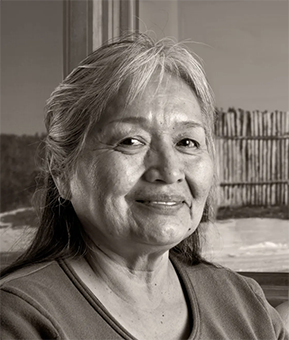Related Research Articles

The Institute of American Indian Arts (IAIA) is a public tribal land-grant college in Santa Fe, New Mexico, United States. The college focuses on Native American art. It operates the Museum of Contemporary Native Arts (MoCNA), which is housed in the historic Santa Fe Federal Building, a landmark Pueblo Revival building listed on the National Register of Historic Places as Federal Building. The museum houses the National Collection of Contemporary Indian Art, with more than 7,000 items.
Raven Chacon is a Diné composer, musician and artist. Born in Fort Defiance, Arizona within the Navajo Nation, Chacon became the first Native American to win a Pulitzer Prize for Music, for his Voiceless Mass in 2022.
Mario Martinez is a Native American contemporary abstract painter. He is a member of the Pascua Yaqui Tribe from New Penjamo, the smallest of six Yaqui settlements, in Arizona. He currently lives in New York City.
Melanie A. Yazzie is a Navajo sculptor, painter, printmaker, and professor. She teaches at the University of Colorado at Boulder.

Charles Sequevya Loloma was a Hopi Native American artist known for his jewelry. He also worked in pottery, painting and ceramics.

Linda Lomahaftewa is a Hopi and Choctaw printmaker, painter, and educator living in Santa Fe, New Mexico.

Gail Bird and Yazzie Johnson are Southwest American Indian artists known for their innovative jewelry which uses varied stones and blends both contemporary and prehistoric design motifs.

Harrison Begay, also known as Haashké yah Níyá was a renowned Diné (Navajo) painter, printmaker, and illustrator. Begay specialized in watercolors, gouache, and silkscreen prints. At the time of his death in 2012, he was the last living, former student of Dorothy Dunn and Geronima C. Montoya at the Santa Fe Indian School. His work has won multiple awards and is exhibited in museums and private collections worldwide and he was among the most famous Diné artists of his generation.
America Meredith is a painter, curator, educator, and editor of First American Art Magazine. America Meredith is an artist and comes from a Swedish-Cherokee background who blends pop imagery from her childhood with European and Native American styles.
Lloyd Henri Kiva New was a pioneer of modern Native American fashion design and a cofounder and president emeritus of the Institute of American Indian Arts (IAIA) in Santa Fe, New Mexico.
Zoë Marieh Urness is a photographer of Alaskan Tlingit and Cherokee Native American heritage. She creates portraits of modern Indigenous cultures in traditional regalia and settings.

Christine McHorse, also known as Christine Nofchissey McHorse, was a Navajo ceramic artist from Santa Fe, New Mexico.
Cannupa Hanska Luger is a New Mexico-based interdisciplinary artist whose community-oriented artworks address environmental justice and gender violence issues.
Melissa Cody is a Navajo textile artist from No Water Mesa, Arizona, United States. Her Germantown Revival style weavings are known for their bold colors and intricate three dimensional patterns. Cody maintains aspects of traditional Navajo tapestries, but also adds her own elements into her work. These elements range from personal tributes to pop culture references.
Cristóbal Martínez is a Chicano artist and the founder of Radio Healer, an indigenous hacker collective. He is a member of Postcommodity, a Southwest Native American Artist collective. His work was featured in the 17th Whitney Biennial, 57th Carnegie International, and the Sundance Film Festival.
Postcommodity, a Southwest Native American Artist collective, was founded in 2007 by Kade Twist and Steve Yazzie Their name refers to the "commodity era" of Native American art trading in the late 1800s and 1900s, with the "post" being in reference to their modern take on traditional Native art forms.
Shonto Begay is a Native American artist, illustrator, writer, and teacher. He began his artistic career in 1983 and his art features landscapes and other cultural elements of Navajo life.
Darren Vigil Gray is a Jicarilla Apache painter and musician. He draws inspiration for his work from abstract expressionists such as Jackson Pollock and from his heritage.
Steven Yazzie is a Native American artist, who is enrolled in the Navajo Nation and of Laguna Pueblo descent of his father's side. He creates video art and installation environments but described painting as his first and most important medium.
References
- 1 2 "Kade L. Twist". Otis College of Art and Design. Retrieved 2020-02-18.
- ↑ Kade Twist Artist Lecture , retrieved 2020-02-18
- ↑ Trecka, Mark. "The Implication of a Fence: Part Three - The Sovereignty of Context". Beacon Broadside. Retrieved 7 May 2024.
- ↑ MFA Fine Arts Faculty. "Kade L. Twist". Otis College Of Art And Design.
- ↑ United States Artists. "Kade Twist". United States Artist.
- ↑ "Minneapolis Institute of Art to Present "When Home Won't Let You Stay: Art and Migration" –– Minneapolis Institute of Art". new.artsmia.org. Retrieved 2020-02-18.
- ↑ "Postcommodity: Repellent Fence - 2015". postcommodity.com. Retrieved 2020-02-18.
- ↑ "Artist Collective Postcommodity on Recovering Knowledge and Making Border Metaphors". Hyperallergic. 2017-05-04. Retrieved 2020-03-11.
- ↑ Kelley, Bill (June 2015). "Reimagining Ceremonies: A Conversation with Postcommodity". Afterall: A Journal of Art, Context and Enquiry. 39: 26–35. doi:10.1086/682834. ISSN 1465-4253.
- ↑ Smith, Chris Coplan, Benjamin Leatherman, Lynn Trimble, Barbara (2020-02-14). "The Best Things to Do in Metro Phoenix This Weekend". Phoenix New Times. Retrieved 2020-02-18.
{{cite web}}: CS1 maint: multiple names: authors list (link) - ↑ "Postcommodity: My Blood is in the Water – 2010". postcommodity.com. Retrieved 2020-03-03.
- ↑ "Results for 'kade Twist' [WorldCat.org]". www.worldcat.org. Retrieved 2020-02-18.
- 1 2 3 "Kade L. Twist | Biography". www.mutualart.com. Retrieved 2020-02-18.
- 1 2 3 4 5 6 Wyatt, Justin (2020-01-29), "United Artists, fourth quarter 1980", United Artists, Routledge, pp. 173–191, doi:10.4324/9780429058332-9a, ISBN 978-0-429-05833-2
- ↑ "United States Artists » Kade Twist" . Retrieved 2020-02-18.
- ↑ "United States Artists » Award" . Retrieved 2020-02-18.